





As a founding employee of Gardener's Supply, I wore many different hats over the years. Currently, I have my own company called Johnnie Brook Creative. The gardens around my home in Richmond, VT, include a large vegetable garden, seasonal greenhouse, cutting garden, perennial gardens, rock garden, shade garden, berry plantings, lots of container plants and a meadow garden. There's no place I'd rather be than in the garden.
Now that it’s late summer, my garden is looking a bit ragged. There's a big bare spot where the Oriental poppies used to be. The globe thistle and Autumn Joy sedum that I didn't get around to dividing last spring have splayed out in all directions. Creeping Charlie is taking over the lavender. Sometimes I feel like just staying indoors by the fan.
If you're having a hard time loving your late summer garden, here are a few ways to rekindle that love:
Identify Friends and Foes
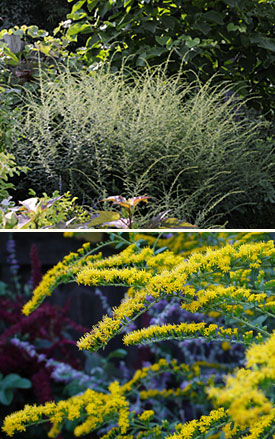
In some gardens, Solidago rugosa (rough-stemmed goldenrod), could be called a thug. After just three seasons, the plant spans five feet. Nevertheless, its feathery foliage adds delicate texture to the back of the border and the flowers make a fine show in late summer and early fall. Regular division will be required to keep it in check.
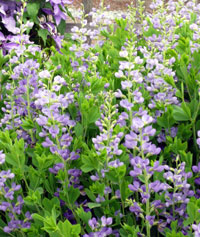
Baptisia australis
Over the years, most gardeners (myself included) accumulate a hodge-podge of perennials. In that collection there are probably a few bad apples that are making a mess of your garden. The truth is, those rampant self-sowers and aggressive-spreaders are far more trouble than they're worth, and the sooner you get them out of your garden the better. If you have an area where they can run wild, fine. But these are not plants that play well with others. A few of the thugs I've gradually eliminated from my garden include:
Here are some well-behaved perennials that (for me) don't spread, don't need staking, don't have pest problems, and are long lived:
Your garden will be more manageable if you start by clearly defining garden and non-garden space. To do so, you can use any type of permanent edging made of plastic, metal, brick or even stone. Then, in the space designated as garden, use mulch to surround the plants you want and smother the ones you don’t. To learn more about different kinds of mulches, read Choosing Mulch for Vegetable Gardens.
Fall is an ideal time to install permanent edging. It’s a bit of a job to put it in, but once it’s in place you’ll thank your stars that you took the time to do it. About 22 years ago, I put a heavy-duty flexible plastic edging around my perennial gardens, vegetable garden and cutting garden. It’s still keeping grass out of the beds and saving me hours of tedious labor.
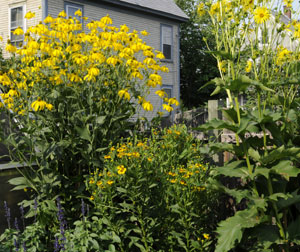
This back-of-the-border set of perennials (from left: Rudbeckia laciniata, Helenium autumnale and Silphium perfoliatum) features plants with similar color and flower form. Plus, two of plants are roughly the same height. This fall, they'll be moved to new sites where they can stand alone.
There are few plants in my garden that didn’t start out in a different location. For me, moving plants around is the only way to figure out what works best where. Late summer, when plants are fully mature, is the best time to plan those moves. It gives you the chance to really see characteristics like height, leaf shape and texture, bloom time and color.
Take a walk around your garden and jot down some of your observations. Bring along some plant markers (I use survey flags) to mark which plants need moving. Then, once the weather cools down, you can cut back these plants and move them to their new location. Be sure to water well for the first couple weeks so the plant’s roots get established before the ground freezes.
Exceptional gardens often have distinctive features such as a wooden pergola, a well-placed sculpture, a collection of colorful birdhouses or an unusual specimen tree. These elements do several things for your garden:
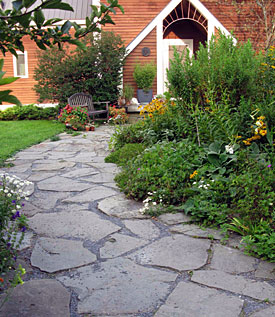
The new walk is flatter and wider, with an area near the entrance for a bench and lots of pots.
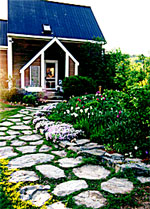
The original stone walkway was too narrow and uneven.
Though it's often easy for me to identify features that would enhance someone else's garden, it's much more difficult to do that in my own yard, where I've been gardening for 22 years. I'm too close to see the whole.
An excellent book called Your House, Your Garden, by Gordon Hayward, helped me think about how people move through a garden, and how to play up distinctive features to create visual impact. It was this book that helped me finally see that the poorly defined walkway up to my front door was a real missed opportunity. Three pallets of stone and five weekends of work later, the front of my house had an entirely different and more pulled-together look.
Late summer is a time to savor your garden. It's too hot to do much else! So grab a cool drink and take a stroll, using your eyes to take it all in. Better yet, invite a gardening friend to join you and see your garden through a fresh pair of eyes. When the weather cools, you'll have lots of fun projects to keep you busy in the garden until the ground freezes.
Copyright © www.100flowers.win Botanic Garden All Rights Reserved